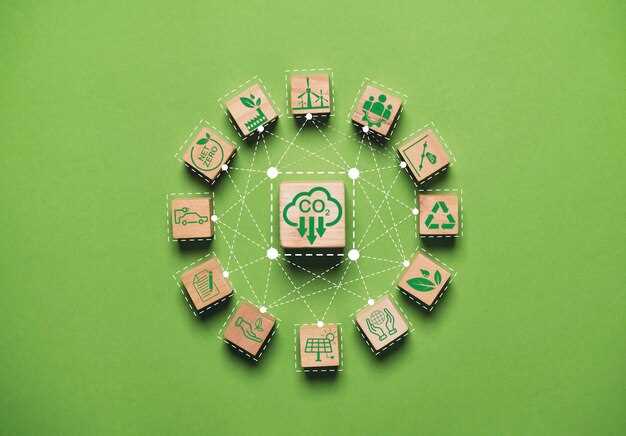Adopt a csrd-aligned roadmap within 90 days to cut emissions that deliver measurable improvements and strengthen loyalty across customers and suppliers. Tie this to your annual sustainability agenda and set specific KPIs for Scope 1-3 emissions, energy and water use, and waste management.
Use predictive algorithms to forecast demand and optimize inventory, lowering stockouts and reducing purchased goods waste. This easier approach helps procurement, logistics, and manufacturing teams achieve measurable service improvements.
Diversify suppliers to reduce risk and improve environmentally sound operations. Include diverse suppliers in csrd reporting and require them to publish data on emissions and water use. Build tradebeyond networks to consolidate routes and cut emissions while meeting the agenda.
Governance ties to fines by implementing automated compliance monitoring and supplier audits. Target lower fines by 20-30% year over year through proactive risk flags and real-time dashboards in the annual report.
Engage peers with transparent data sharing, benchmarking, and collaborative improvement plans. Align incentives with sustainability targets, and reward suppliers that consistently meet environmental standards across the purchased portfolio.
Practical Actions for Reducing Footprint While Controlling Costs
Audit supplier spend and consolidate the supplier base to cut spend by 12–18% while preserving service levels. Map spend by category, collect data on emissions, and negotiate volume discounts. This approach yields reductions in emissions and waste when paired with route optimization and packaging changes. Target a 6–12 month implementation window for quick wins and set quarterly reviews to track progress.
Adopt a life-cycle approach to procurement: include supplier selection, logistics, end-of-life handling, and product design decisions in the decision process. Involve purchasing and operations in a cross-functional team to track each process and collect data from suppliers. Leverage data to identify opportunities for reductions in energy, water, and material intensity.
Leverage automation to cut manual steps, shorten cycle times, and lower energy spend. Automate invoicing, demand planning, and route optimization to cut operating costs by 15–25% in the first year. Use means such as supplier scorecards, spend analytics, and automated contract workflows to speed decisions. Ensure data is collected across the network to support continuous improvements.
Inclusion and ngos: broaden supplier base to include diverse entities, including ngos that deliver programs with lower costs and higher social impact. This play strengthens resilience and opens access to local solutions. Promoting collaboration with community organizations helps drive sustainable practices together with suppliers.
End-of-life and circularity: design for end-of-life, collect recyclable materials, and promote re-use across the life cycle of products. Create a simple qualification for end-of-life handling and set milestones for purchased goods to shift toward recycled content. This yields reductions in landfill waste and materials extraction over two years.
Extraction and material choices: favor suppliers that disclose material footprints and choose alternatives with lower embedded energy. Build a short list of materials with the lowest extraction footprint and track savings in emissions and water use. This means a disciplined evaluation during supplier selection and product design stages.
Next steps and governance: set clear priorities, assign owners, and collect KPIs weekly. If a supplier shows inaction, switch to higher-performing alternatives. Maintain focus on life-cycle goals across the end-to-end chain.
| Toiminta | Omistaja | Timeframe | Vaikutus | Resources |
|---|---|---|---|---|
| Audit and consolidate supplier spend | Sourcing Lead | 0–6 months | 12–18% spend reductions, maintained service | Spend analytics, contract templates |
| Route optimization and packaging changes | Logistics Manager | 6–12 months | 10–20% emissions and packaging waste reductions | Route optimization software, packaging redesign |
| Procurement process automation | Digital Transformation Lead | 6–12 months | 15–25% operating cost reductions | Automation platform, contracted workflows |
| Inclusive sourcing program | CSR/Procurement Manager | 12 months | Resilience gains and cost efficiencies via diverse suppliers | Supplier development budget, onboarding |
| End-of-life and recycling program | Sustainability Lead | 12–24 months | Waste reductions, higher recycled content | Recycling contracts, take-back schemes |
Establish Clear Supplier Carbon Metrics and Targets
Define a baseline emissions profile for each supplier across scopes 1-3 using structured data collection protocols and a quarterly questionnaire; monitor progress and share results with customers.
Set increasing targets by supplier and category, anchored to the baseline and aligned with science-based methods; embed them into procurement contracts and review them annually with clear milestones.
Address travel and commuting emissions explicitly: require data for business travel and employee commuting in scope 3, and offer optional calculator tools for suppliers to estimate these impacts.
Adopt holistic metrics that cover energy use, logistics, and product lifecycle impacts; considering supplier capabilities, requiring data quality checks and establishing monitoring thresholds to trigger corrective actions.
For a partner like spinnova, tailor metrics to material choices and manufacturing routes; define data sharing rights, and provide training to suppliers to increase informed decision-making.
Governance and incentives: appoint a sustainability owner for each supplier, set a quarterly review cadence, publish structured dashboards and anonymized summaries to customers, and link contract terms to demonstrated progress.
Require Transparent Carbon Disclosure and Regular Audits
Publish annual, externally verified carbon disclosures for your company, aligned with the TCFD framework and the GHG Protocol, and require independent audits to validate data accuracy and methodologies. This practice establishes trust with customers and communities and enables achieving measurable progress over time.
Adopt a comprehensive disclosure scope, covering Scopes 1, 2, and 3 with facility- and product-level detail. For plastics-heavy packaging, include upstream resin suppliers, downstream packaging, and end-of-life management. Build a data route that captures energy use, emissions factors, and process efficiencies, and assess data quality at least quarterly. Use clear indicators such as CO2e per unit, energy intensity (MJ per unit), and share of renewable energy to benchmark performance, while documenting calculation methods and materiality thresholds for internal alignment, including how data is reconciled across sites.
Implement annual, independent audits to verify disclosed figures and control processes. Require suppliers to submit emissions data and governance evidence, and verify a representative sample with dedicated professionals in procurement and sustainability. Audits should assess data governance, calculations, data systems, and compliance with relevant standards (ISO 14064-3, CDP questionnaires). Use findings to drive internal improvements and to guide actions with a concrete corrective action plan.
Encourage robust scenario analyses to evaluate potential impacts under 1.5°C and 2°C warming, including supply disruptions, price volatility, and health risks to workers. Link results to decision-making, guiding capital allocation, supplier development, and risk mitigation. Present publicly relevant indicators and scenario outcomes to customers, investors, and community partners to demonstrate progress and accountability, positively affecting trust and brand health.
Actions for teams: appoint a disclosure owner who coordinates across functions; align data systems across internally coordinated units; integrate supplier disclosures into onboarding and ongoing supplier management; set measurable annual targets and publish them in sustainability reports; train professionals across finance, operations, and procurement to ensure compliant data handling; maintain a transparent documentation trail to support external audits and internal accountability.
Redesign Transportation Network to Cut Distances and Emissions
Start by mapping the current network across all facilities, carriers, and routes, then identify the top 20% of corridors that drive the majority of mileage. Redesign these corridors to compress distances by 15-25% and shift to regional hubs within 150-300 km of key demand clusters to cut fuel use and emissions in the first year. This approach builds directly toward your vision of a leaner, lower-emission network.
Steps include establishing regional hubs within 150-300 km of core markets, co-locating warehousing and cross-dock services, and reorganizing lanes so most shipments move through a single consolidated route instead of multiple hops.
Labor shifts demand new job profiles: hub operators, data-driven planners, and dock validators. Invest in training for cross-docking, safety, and equipment handling to shorten cycle times and reduce idle labor costs.
Internally track progress with a unified traceability system that records route, carrier, mode, weight, distance, and emissions per shipment. Use real-time dashboards to detect deviations and trigger corrective actions within 24 hours.
Penalties deter avoidable detours and underutilized capacity, while service-level penalties push carriers to adhere to preferred corridors. Pair penalties with incentives for routes that achieve target mile reductions and emissions per tonne-km.
Adopt a holistic view of the whole network that weighs fleet mix, modal transitions, and last-mile constraints. The built model includes third-party services and is validated through pilot runs before scale.
Define indicators such as average distance per shipment, CO2e per tonne-km, and on-time delivery rate; publish a monthly report to leadership and key partners to drive accountability and continuous improvement.
Strategies address challenges like capacity constraints, regulatory gaps, and seasonal spikes by reserving capacity in advance, diversifying carriers, and using dynamic routing software. Establishing collaboration with suppliers and forwarders to share demand signals reduces empty miles.
Throughout implementation, establish a cross-functional governance team and adopt the lksg data-exchange standard to ensure consistent data across systems, warehouses, and carriers. This alignment reduces data latency and builds trust with partners.
Achieving the sustainability vision requires clear actions and a roadmap that promotes transparency, accountability, and continuous learning. Communicate milestones to teams, customers, and regulators, and link incentives to performance against the defined indicators.
Better outcomes materialize as 10-20% fewer miles, 5-15% lower fuel burn, and improved service levels within 12 months. Track progress with a quarterly report, adjust routes, and scale successful pilots across regions to sustain gains.
Localize Sourcing or Nearshore Key Suppliers to Shorten Lead Times

Establish a regional sourcing network by prioritizing the five closest suppliers capable of meeting quality and volume, then move 40-60% of orders to nearshore operations to shorten lead times by about 30-50% on the most time-sensitive SKUs.
Gaining resilience starts with a focused assessment of what to move closer. Map critical components, their current line lead times, and the points where delays most often occur. Create a baseline to measure improvement over the next quarter and use it to follow a tight plan with suppliers.
- Focused supplier profiling: shortlist 3-6 regional producers within a practical logistics radius; verify capacity, quality credentials, and the ability to scale during peak demand; compare regional wages and labor practices to ensure alignment with standards.
- Structured SLAs and incentives: define on-time delivery targets, changeover times, and defect thresholds; tie pricing to service levels and offer incentives for early shipments to enable faster replenishment.
- Joint demand planning: implement a shared weekly forecast, set batching that minimizes line stops, and establish a rapid-response protocol for demand shifts; this enables smoother production flow and reduces last-minute freight.
- Logistics optimization: leverage regional hubs, cross-docking, and optimized transport routes; monitor shipments in real time and follow automated alerts for deviations to keep the line moving.
- Sustainability alignment: select partners with climate-related efficiency measures and recycling programs for packaging; promote practices that reduce emissions and packaging waste while keeping costs predictable.
Understand the total cost picture beyond unit price–wages, benefits, and compliance costs can shift depending on location; run a TCO model to compare nearshore versus offshore scenarios and identify where savings in logistics and lead time offset orderly wage differences.
Leveraging the closest suppliers yields the biggest advantage in responsiveness. Gaining momentum requires a simple points-based review: delivery reliability, quality, responsiveness, and packaging sustainability. Track progress, follow the data, and use results to promote continued improvement across the ecosystem; engaging peers and government programs where appropriate helps sustain momentum and reinforce the move. About every quarter, reassess the network to ensure you are reducing risk while maintaining efficient operations.
Upgrade Warehousing with Energy Management and Low-Carbon Technologies

Install an innovative energy management system (EMS) with zone submetering for lighting, HVAC, and refrigeration; pair it with a transparent dashboard and per month updates to drive improving energy intensity by 15–25% in the first year.
Target early upgrades in two priorities: lighting and refrigeration. Replace T12/T8 fixtures with LEDs, install smart occupancy sensors, and deploy VFDs on fans and pumps. In cold storage, tighten door seals and implement cold-aisle containment. These actions yield a 12–18 month payback and deliver focused gains month by month, accelerating the path to cost savings.
Add solar PV on warehouse rooftops to offset daytime loads and pair with a compact battery for peak shaving. Use advanced, low-GWP refrigerants and heat pump cooling where suitable to cut climate impact. Ensure data integrity and maintain transparent sfdr-aligned disclosures; share data with stakeholders to build trust and track progress.
Establishing a cross-functional team of professionals from maintenance, facilities, and procurement ensures focused execution. Define next actions, keep priorities clear, and continue adjustment cycles with regular reviews to stay sure about progress. Keep easy, repeatable onboarding and governance to sustain momentum across sites.
Organizations pursuing these upgrades can realize longer savings, improve reliability, and positively impact climate while eliminating wasteful energy use. Maintain alignment with organizational goals and push for measurable results that show up in energy and cost metrics.
To secure longer-term value, monitor energy intensity, carbon emissions per unit, and equipment availability. Schedule quarterly reviews, adjust targets as conditions shift, and continue engaging external experts to keep plans innovative and aligned with climate goals while eliminating waste. This approach promotes ongoing improvement and keeps data transparent for stakeholders.

 Top Strategies for Enhancing Supply Chain Sustainability">
Top Strategies for Enhancing Supply Chain Sustainability">
